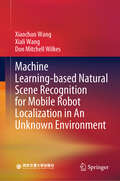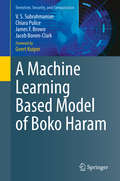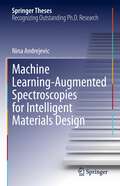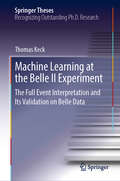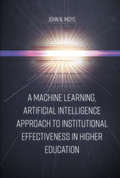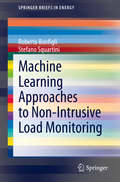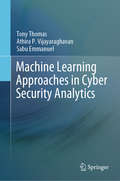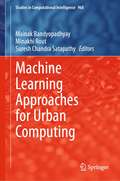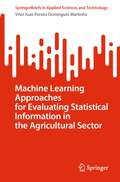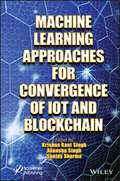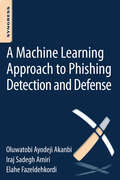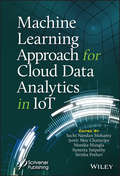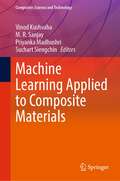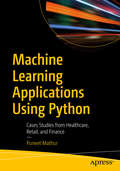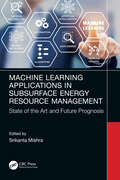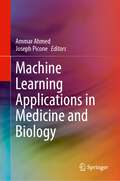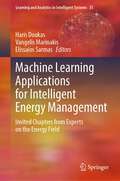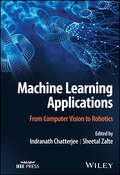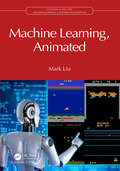- Table View
- List View
Machine Learning-based Natural Scene Recognition for Mobile Robot Localization in An Unknown Environment
by Xiaochun Wang Xiali Wang Don Mitchell WilkesThis book advances research on mobile robot localization in unknown environments by focusing on machine-learning-based natural scene recognition. The respective chapters highlight the latest developments in vision-based machine perception and machine learning research for localization applications, and cover such topics as: image-segmentation-based visual perceptual grouping for the efficient identification of objects composing unknown environments; classification-based rapid object recognition for the semantic analysis of natural scenes in unknown environments; the present understanding of the Prefrontal Cortex working memory mechanism and its biological processes for human-like localization; and the application of this present understanding to improve mobile robot localization. The book also features a perspective on bridging the gap between feature representations and decision-making using reinforcement learning, laying the groundwork for future advances in mobile robot navigation research.
A Machine Learning Based Model of Boko Haram (Terrorism, Security, and Computation)
by V. S. Subrahmanian Chiara Pulice James F. Brown Jacob Bonen-ClarkThis is the first study of Boko Haram that brings advanced data-driven, machine learning models to both learn models capable of predicting a wide range of attacks carried out by Boko Haram, as well as develop data-driven policies to shape Boko Haram’s behavior and reduce attacks by them. This book also identifies conditions that predict sexual violence, suicide bombings and attempted bombings, abduction, arson, looting, and targeting of government officials and security installations. After reducing Boko Haram’s history to a spreadsheet containing monthly information about different types of attacks and different circumstances prevailing over a 9 year period, this book introduces Temporal Probabilistic (TP) rules that can be automatically learned from data and are easy to explain to policy makers and security experts. This book additionally reports on over 1 year of forecasts made using the model in order to validate predictive accuracy. It also introduces a policy computation method to rein in Boko Haram’s attacks.Applied machine learning researchers, machine learning experts and predictive modeling experts agree that this book is a valuable learning asset. Counter-terrorism experts, national and international security experts, public policy experts and Africa experts will also agree this book is a valuable learning tool.
Machine Learning-Augmented Spectroscopies for Intelligent Materials Design (Springer Theses)
by Nina AndrejevicThe thesis contains several pioneering results at the intersection of state-of-the-art materials characterization techniques and machine learning. The use of machine learning empowers the information extraction capability of neutron and photon spectroscopies. In particular, new knowledge and new physics insights to aid spectroscopic analysis may hold great promise for next-generation quantum technology. As a prominent example, the so-called proximity effect at topological material interfaces promises to enable spintronics without energy dissipation and quantum computing with fault tolerance, yet the characteristic spectral features to identify the proximity effect have long been elusive. The work presented within permits a fine resolution of its spectroscopic features and a determination of the proximity effect which could aid further experiments with improved interpretability. A few novel machine learning architectures are proposed in this thesis work which leverage the case when the data is scarce and utilize the internal symmetry of the system to improve the training quality. The work sheds light on future pathways to apply machine learning to augment experiments.
Machine Learning at the Belle II Experiment: The Full Event Interpretation and Its Validation on Belle Data (Springer Theses)
by Thomas KeckThis book explores how machine learning can be used to improve the efficiency of expensive fundamental science experiments. The first part introduces the Belle and Belle II experiments, providing a detailed description of the Belle to Belle II data conversion tool, currently used by many analysts. The second part covers machine learning in high-energy physics, discussing the Belle II machine learning infrastructure and selected algorithms in detail. Furthermore, it examines several machine learning techniques that can be used to control and reduce systematic uncertainties. The third part investigates the important exclusive B tagging technique, unique to physics experiments operating at the Υ resonances, and studies in-depth the novel Full Event Interpretation algorithm, which doubles the maximum tag-side efficiency of its predecessor. The fourth part presents a complete measurement of the branching fraction of the rare leptonic B decay “B→tau nu”, which is used to validate the algorithms discussed in previous parts.
A Machine Learning, Artificial Intelligence Approach to Institutional Effectiveness in Higher Education
by John N. MoyeThe Institutional Research profession is currently experimenting with many strategies to assess institutional effectiveness in a manner that reflects the letter and spirit of their unique mission, vision, and values. While a "best-practices" approach to the measurement and assessment of institutional functions is prevalent in the literature, a machine learning approach that synthesizes these parts into a coherent and synergistic approach has not emerged. A Machine Learning, Artificial Intelligence Approach to Institutional Effectiveness in Higher Education presents a practical, effective, and systematic approach to the measurement, assessment, and sensemaking of institutional performance. Included are instruments and strategies to measure and assess the performance of Curriculum, Learning, Instruction, Support Services, and Program Feasibility as well as a meaningful Environmental Scanning method. The data collected in this system are organized into assessments of institutional effectiveness through the application of machine learning data processes that create an artificial intelligence model of actual institutional performance from the raw performance data. This artificial intelligence is visualized through five organizational sensemaking approaches to monitor, demonstrate, and improve institutional performance. Thus, this book provides a set of tools that can be adopted or adapted to the specific intentions of any institution, making it an invaluable resource for Higher Education administrators, leaders and practitioners.
A Machine Learning, Artificial Intelligence Approach to Institutional Effectiveness in Higher Education
by John N. MoyeThe Institutional Research profession is currently experimenting with many strategies to assess institutional effectiveness in a manner that reflects the letter and spirit of their unique mission, vision, and values. While a "best-practices" approach to the measurement and assessment of institutional functions is prevalent in the literature, a machine learning approach that synthesizes these parts into a coherent and synergistic approach has not emerged. A Machine Learning, Artificial Intelligence Approach to Institutional Effectiveness in Higher Education presents a practical, effective, and systematic approach to the measurement, assessment, and sensemaking of institutional performance. Included are instruments and strategies to measure and assess the performance of Curriculum, Learning, Instruction, Support Services, and Program Feasibility as well as a meaningful Environmental Scanning method. The data collected in this system are organized into assessments of institutional effectiveness through the application of machine learning data processes that create an artificial intelligence model of actual institutional performance from the raw performance data. This artificial intelligence is visualized through five organizational sensemaking approaches to monitor, demonstrate, and improve institutional performance. Thus, this book provides a set of tools that can be adopted or adapted to the specific intentions of any institution, making it an invaluable resource for Higher Education administrators, leaders and practitioners.
Machine Learning Approaches to Non-Intrusive Load Monitoring (SpringerBriefs in Energy)
by Roberto Bonfigli Stefano SquartiniResearch on Smart Grids has recently focused on the energy monitoring issue, with the objective of maximizing the user consumption awareness in building contexts on the one hand, and providing utilities with a detailed description of customer habits on the other. In particular, Non-Intrusive Load Monitoring (NILM), the subject of this book, represents one of the hottest topics in Smart Grid applications. NILM refers to those techniques aimed at decomposing the consumption-aggregated data acquired at a single point of measurement into the diverse consumption profiles of appliances operating in the electrical system under study. This book provides a status report on the most promising NILM methods, with an overview of the publically available dataset on which the algorithm and experiments are based. Of the proposed methods, those based on the Hidden Markov Model (HMM) and the Deep Neural Network (DNN) are the best performing and most interesting from the future improvement point of view. One method from each category has been selected and the performance improvements achieved are described. Comparisons are made between the two reference techniques, and pros and cons are considered. In addition, performance improvements can be achieved when the reactive power component is exploited in addition to the active power consumption trace.
Machine Learning Approaches in Cyber Security Analytics
by Tony Thomas Sabu Emmanuel Athira P. VijayaraghavanThis book introduces various machine learning methods for cyber security analytics. With an overwhelming amount of data being generated and transferred over various networks, monitoring everything that is exchanged and identifying potential cyber threats and attacks poses a serious challenge for cyber experts. Further, as cyber attacks become more frequent and sophisticated, there is a requirement for machines to predict, detect, and identify them more rapidly. Machine learning offers various tools and techniques to automate and quickly predict, detect, and identify cyber attacks.
Machine Learning Approaches for Urban Computing (Studies in Computational Intelligence #968)
by Mainak Bandyopadhyay Minakhi Rout Suresh Chandra SatapathyThis book discusses various machine learning applications and models, developed using heterogeneous data, which helps in a comprehensive prediction, optimization, association analysis, cluster analysis and classification-related applications for various activities in urban area. It details multiple types of data generating from urban activities and suitability of various machine learning algorithms for handling urban data. The book is helpful for researchers, academicians, faculties, scientists and geospatial industry professionals for their research work and sets new ideas in the field of urban computing.
Machine Learning Approaches for Evaluating Statistical Information in the Agricultural Sector (SpringerBriefs in Applied Sciences and Technology)
by Vitor Joao MartinhoThis book presents machine learning approaches to identify the most important predictors of crucial variables for dealing with the challenges of managing production units and designing agriculture policies. The book focuses on the agricultural sector in the European Union and considers statistical information from the Farm Accountancy Data Network (FADN).Presently, statistical databases present a lot of information for many indicators and, in these contexts, one of the main tasks is to identify the most important predictors of certain indicators. In this way, the book presents approaches to identifying the most relevant variables that best support the design of adjusted farming policies and management plans. These subjects are currently important for students, public institutions and farmers. To achieve these objectives, the book considers the IBM SPSS Modeler procedures as well as the respective models suggested by this software.The book is read by students in production engineering, economics and agricultural studies, public bodies and managers in the farming sector.
Machine Learning Approaches for Convergence of IoT and Blockchain
by Krishna Kant Singh Akansha Singh Sanjay SharmaThe digital revolution is characterized by the convergence of technologies, rapidly advancing the 4th industrial revolution thereby blurring the lines between physical, digital and biological objects. The speed of the fourth revolution which evolves at an exponential rate cannot by any means be compared with any previous technologies. AI and IoT employ the interactions and operations in various fields such as home appliances, autonomous vehicles, nanotechnology, robotics, cognitive systems, self-driving cars and wearable devices. The potential of blockchain technology is realized in many sectors as security plays a crucial role everywhere. This book deeply discusses two of the most critical emerging fields of machine learning: blockchain technology and the Internet of Things.
Machine Learning Approaches for Convergence of IoT and Blockchain
by Krishna Kant Singh Akansha Singh Sanjay K. SharmaThe digital revolution is characterized by the convergence of technologies, rapidly advancing the 4th industrial revolution thereby blurring the lines between physical, digital and biological objects. The speed of the fourth revolution which evolves at an exponential rate cannot by any means be compared with any previous technologies. AI and IoT employ the interactions and operations in various fields such as home appliances, autonomous vehicles, nanotechnology, robotics, cognitive systems, self-driving cars and wearable devices. The potential of blockchain technology is realized in many sectors as security plays a crucial role everywhere. This book deeply discusses two of the most critical emerging fields of machine learning: blockchain technology and the Internet of Things.
A Machine-Learning Approach to Phishing Detection and Defense
by O.A. Akanbi Iraj Sadegh Amiri E. FazeldehkordiPhishing is one of the most widely-perpetrated forms of cyber attack, used to gather sensitive information such as credit card numbers, bank account numbers, and user logins and passwords, as well as other information entered via a web site. The authors of A Machine-Learning Approach to Phishing Detetion and Defense have conducted research to demonstrate how a machine learning algorithm can be used as an effective and efficient tool in detecting phishing websites and designating them as information security threats. This methodology can prove useful to a wide variety of businesses and organizations who are seeking solutions to this long-standing threat. A Machine-Learning Approach to Phishing Detetion and Defense also provides information security researchers with a starting point for leveraging the machine algorithm approach as a solution to other information security threats.Discover novel research into the uses of machine-learning principles and algorithms to detect and prevent phishing attacksHelp your business or organization avoid costly damage from phishing sourcesGain insight into machine-learning strategies for facing a variety of information security threats
Machine Learning Approach for Cloud Data Analytics in IoT
by Sachi Nandan Mohanty Jyotir Moy Chatterjee Monika Mangla Suneeta Satpathy Sirisha PotluriIn this era of IoT, edge devices generate gigantic data during every fraction of a second. The main aim of these networks is to infer some meaningful information from the collected data. For the same, the huge data is transmitted to the cloud which is highly expensive and time-consuming. Hence, it needs to devise some efficient mechanism to handle this huge data, thus necessitating efficient data handling techniques. Sustainable computing paradigms like cloud and fog are expedient to capably handle the issues of performance, capabilities allied to storage and processing, maintenance, security, efficiency, integration, cost, energy and latency. However, it requires sophisticated analytics tools so as to address the queries in an optimized time. Hence, rigorous research is taking place in the direction of devising effective and efficient framework to garner utmost advantage. Machine learning has gained unmatched popularity for handling massive amounts of data and has applications in a wide variety of disciplines, including social media. Machine Learning Approach for Cloud Data Analytics in IoT details and integrates all aspects of IoT, cloud computing and data analytics from diversified perspectives. It reports on the state-of-the-art research and advanced topics, thereby bringing readers up to date and giving them a means to understand and explore the spectrum of applications of IoT, cloud computing and data analytics.
Machine Learning Approach for Cloud Data Analytics in IoT
by Sachi Nandan Mohanty Jyotir Moy Chatterjee Monika Mangla Suneeta Satpathy Sirisha PotluriIn this era of IoT, edge devices generate gigantic data during every fraction of a second. The main aim of these networks is to infer some meaningful information from the collected data. For the same, the huge data is transmitted to the cloud which is highly expensive and time-consuming. Hence, it needs to devise some efficient mechanism to handle this huge data, thus necessitating efficient data handling techniques. Sustainable computing paradigms like cloud and fog are expedient to capably handle the issues of performance, capabilities allied to storage and processing, maintenance, security, efficiency, integration, cost, energy and latency. However, it requires sophisticated analytics tools so as to address the queries in an optimized time. Hence, rigorous research is taking place in the direction of devising effective and efficient framework to garner utmost advantage. Machine learning has gained unmatched popularity for handling massive amounts of data and has applications in a wide variety of disciplines, including social media. Machine Learning Approach for Cloud Data Analytics in IoT details and integrates all aspects of IoT, cloud computing and data analytics from diversified perspectives. It reports on the state-of-the-art research and advanced topics, thereby bringing readers up to date and giving them a means to understand and explore the spectrum of applications of IoT, cloud computing and data analytics.
Machine Learning Applied to Composite Materials (Composites Science and Technology)
by Vinod Kushvaha M. R. Sanjay Priyanka Madhushri Suchart SiengchinThis book introduces the approach of Machine Learning (ML) based predictive models in the design of composite materials to achieve the required properties for certain applications. ML can learn from existing experimental data obtained from very limited number of experiments and subsequently can be trained to find solutions of the complex non-linear, multi-dimensional functional relationships without any prior assumptions about their nature. In this case the ML models can learn from existing experimental data obtained from (1) composite design based on various properties of the matrix material and fillers/reinforcements (2) material processing during fabrication (3) property relationships. Modelling of these relationships using ML methods significantly reduce the experimental work involved in designing new composites, and therefore offer a new avenue for material design and properties. The book caters to students, academics and researchers who are interested in the field of material composite modelling and design.
Machine Learning Applications Using Python: Cases Studies from Healthcare, Retail, and Finance
by Puneet MathurGain practical skills in machine learning for finance, healthcare, and retail. This book uses a hands-on approach by providing case studies from each of these domains: you’ll see examples that demonstrate how to use machine learning as a tool for business enhancement. As a domain expert, you will not only discover how machine learning is used in finance, healthcare, and retail, but also work through practical case studies where machine learning has been implemented. Machine Learning Applications Using Python is divided into three sections, one for each of the domains (healthcare, finance, and retail). Each section starts with an overview of machine learning and key technological advancements in that domain. You’ll then learn more by using case studies on how organizations are changing the game in their chosen markets. This book has practical case studies with Python code and domain-specific innovative ideas for monetizing machine learning. What You Will LearnDiscover applied machine learning processes and principlesImplement machine learning in areas of healthcare, finance, and retailAvoid the pitfalls of implementing applied machine learningBuild Python machine learning examples in the three subject areasWho This Book Is ForData scientists and machine learning professionals.
Machine Learning Applications in Subsurface Energy Resource Management: State of the Art and Future Prognosis
by Srikanta MishraThe utilization of machine learning (ML) techniques to understand hidden patterns and build data-driven predictive models from complex multivariate datasets is rapidly increasing in many applied science and engineering disciplines, including geo-energy. Motivated by these developments, Machine Learning Applications in Subsurface Energy Resource Management presents a current snapshot of the state of the art and future outlook for ML applications to manage subsurface energy resources (e.g., oil and gas, geologic carbon sequestration, and geothermal energy). Covers ML applications across multiple application domains (reservoir characterization, drilling, production, reservoir modeling, and predictive maintenance) Offers a variety of perspectives from authors representing operating companies, universities, and research organizations Provides an array of case studies illustrating the latest applications of several ML techniques Includes a literature review and future outlook for each application domain This book is targeted at practicing petroleum engineers or geoscientists interested in developing a broad understanding of ML applications across several subsurface domains. It is also aimed as a supplementary reading for graduate-level courses and will also appeal to professionals and researchers working with hydrogeology and nuclear waste disposal.
Machine Learning Applications in Subsurface Energy Resource Management: State of the Art and Future Prognosis
by Srikanta MishraThe utilization of machine learning (ML) techniques to understand hidden patterns and build data-driven predictive models from complex multivariate datasets is rapidly increasing in many applied science and engineering disciplines, including geo-energy. Motivated by these developments, Machine Learning Applications in Subsurface Energy Resource Management presents a current snapshot of the state of the art and future outlook for ML applications to manage subsurface energy resources (e.g., oil and gas, geologic carbon sequestration, and geothermal energy). Covers ML applications across multiple application domains (reservoir characterization, drilling, production, reservoir modeling, and predictive maintenance) Offers a variety of perspectives from authors representing operating companies, universities, and research organizations Provides an array of case studies illustrating the latest applications of several ML techniques Includes a literature review and future outlook for each application domain This book is targeted at practicing petroleum engineers or geoscientists interested in developing a broad understanding of ML applications across several subsurface domains. It is also aimed as a supplementary reading for graduate-level courses and will also appeal to professionals and researchers working with hydrogeology and nuclear waste disposal.
Machine Learning Applications in Medicine and Biology
by Ammar Ahmed Joseph PiconeThis book combines selected papers from the 2022 IEEE Signal Processing in Medicine and Biology Symposium (IEEE SPMB) held at Temple University. The symposium presents multidisciplinary research in the life sciences. Topics covered include:Signal and image analysis (EEG, ECG, MRI)Machine learningData mining and classificationBig data resourcesApplications of particular interest at the 2022 symposium included digital pathology, computational biology, and quantum computing. The book features tutorials and examples of successful applications that will appeal to a wide range of professionals and researchers in signal processing, medicine, and biology.
Machine Learning Applications for Intelligent Energy Management: Invited Chapters from Experts on the Energy Field (Learning and Analytics in Intelligent Systems #35)
by Haris Doukas Vangelis Marinakis Elissaios SarmasAs carbon dioxide (CO2) emissions and other greenhouse gases constantly rise and constitute the main contributor to climate change, temperature rise and global warming, artificial intelligence, big data, Internet of things, and blockchain technologies are enlisted to help enforce energy transition and transform the entire energy sector. The book at hand presents state-of-the-art developments in artificial intelligence-empowered analytics of energy data and artificial intelligence-empowered application development. Topics covered include a presentation of the various stakeholders in the energy sector and their corresponding required analytic services, such as state-of-the-art machine learning, artificial intelligence, and optimization models and algorithms tailored for a series of demanding energy problems and aiming at providing optimal solutions under specific constraints. Professors, researchers, scientists, engineers, and students in energy sector-related disciplines are expected to be inspired and benefit from this book, along with readers from other disciplines wishing to learn more about this exciting new field of research.
Machine Learning Applications: From Computer Vision to Robotics
by Indranath Chatterjee Sheetal ZalteMachine Learning Applications Practical resource on the importance of Machine Learning and Deep Learning applications in various technologies and real-world situations Machine Learning Applications discusses methodological advancements of machine learning and deep learning, presents applications in image processing, including face and vehicle detection, image classification, object detection, image segmentation, and delivers real-world applications in healthcare to identify diseases and diagnosis, such as creating smart health records and medical imaging diagnosis, and provides real-world examples, case studies, use cases, and techniques to enable the reader’s active learning. Composed of 13 chapters, this book also introduces real-world applications of machine and deep learning in blockchain technology, cyber security, and climate change. An explanation of AI and robotic applications in mechanical design is also discussed, including robot-assisted surgeries, security, and space exploration. The book describes the importance of each subject area and detail why they are so important to us from a societal and human perspective. Edited by two highly qualified academics and contributed to by established thought leaders in their respective fields, Machine Learning Applications includes information on: Content based medical image retrieval (CBMIR), covering face and vehicle detection, multi-resolution and multisource analysis, manifold and image processing, and morphological processing Smart medicine, including machine learning and artificial intelligence in medicine, risk identification, tailored interventions, and association rules AI and robotics application for transportation and infrastructure (e.g., autonomous cars and smart cities), along with global warming and climate change Identifying diseases and diagnosis, drug discovery and manufacturing, medical imaging diagnosis, personalized medicine, and smart health records With its practical approach to the subject, Machine Learning Applications is an ideal resource for professionals working with smart technologies such as machine and deep learning, AI, IoT, and other wireless communications; it is also highly suitable for professionals working in robotics, computer vision, cyber security and more.
Machine Learning Applications: From Computer Vision to Robotics
by Indranath Chatterjee Sheetal ZalteMachine Learning Applications Practical resource on the importance of Machine Learning and Deep Learning applications in various technologies and real-world situations Machine Learning Applications discusses methodological advancements of machine learning and deep learning, presents applications in image processing, including face and vehicle detection, image classification, object detection, image segmentation, and delivers real-world applications in healthcare to identify diseases and diagnosis, such as creating smart health records and medical imaging diagnosis, and provides real-world examples, case studies, use cases, and techniques to enable the reader’s active learning. Composed of 13 chapters, this book also introduces real-world applications of machine and deep learning in blockchain technology, cyber security, and climate change. An explanation of AI and robotic applications in mechanical design is also discussed, including robot-assisted surgeries, security, and space exploration. The book describes the importance of each subject area and detail why they are so important to us from a societal and human perspective. Edited by two highly qualified academics and contributed to by established thought leaders in their respective fields, Machine Learning Applications includes information on: Content based medical image retrieval (CBMIR), covering face and vehicle detection, multi-resolution and multisource analysis, manifold and image processing, and morphological processing Smart medicine, including machine learning and artificial intelligence in medicine, risk identification, tailored interventions, and association rules AI and robotics application for transportation and infrastructure (e.g., autonomous cars and smart cities), along with global warming and climate change Identifying diseases and diagnosis, drug discovery and manufacturing, medical imaging diagnosis, personalized medicine, and smart health records With its practical approach to the subject, Machine Learning Applications is an ideal resource for professionals working with smart technologies such as machine and deep learning, AI, IoT, and other wireless communications; it is also highly suitable for professionals working in robotics, computer vision, cyber security and more.
Machine Learning, Animated (Chapman And Hall/crc Machine Learning And Pattern Recognition Ser.)
by Mark LiuThe release of ChatGPT has kicked off an arms race in Machine Learning (ML), however ML has also been described as a black box and very hard to understand. Machine Learning, Animated eases you into basic ML concepts and summarizes the learning process in three words: initialize, adjust and repeat. This is illustrated step by step with animation to show how machines learn: from initial parameter values to adjusting each step, to the final converged parameters and predictions. This book teaches readers to create their own neural networks with dense and convolutional layers, and use them to make binary and multi-category classifications. Readers will learn how to build deep learning game strategies and combine this with reinforcement learning, witnessing AI achieve super-human performance in Atari games such as Breakout, Space Invaders, Seaquest and Beam Rider. Written in a clear and concise style, illustrated with animations and images, this book is particularly appealing to readers with no background in computer science, mathematics or statistics. Access the book's repository at: https://github.com/markhliu/MLA
Machine Learning, Animated (Chapman And Hall/crc Machine Learning And Pattern Recognition Ser.)
by Mark LiuThe release of ChatGPT has kicked off an arms race in Machine Learning (ML), however ML has also been described as a black box and very hard to understand. Machine Learning, Animated eases you into basic ML concepts and summarizes the learning process in three words: initialize, adjust and repeat. This is illustrated step by step with animation to show how machines learn: from initial parameter values to adjusting each step, to the final converged parameters and predictions. This book teaches readers to create their own neural networks with dense and convolutional layers, and use them to make binary and multi-category classifications. Readers will learn how to build deep learning game strategies and combine this with reinforcement learning, witnessing AI achieve super-human performance in Atari games such as Breakout, Space Invaders, Seaquest and Beam Rider. Written in a clear and concise style, illustrated with animations and images, this book is particularly appealing to readers with no background in computer science, mathematics or statistics. Access the book's repository at: https://github.com/markhliu/MLA
